Golden Jubilee Peach Tree
- June 29, 2023
- 0 comment
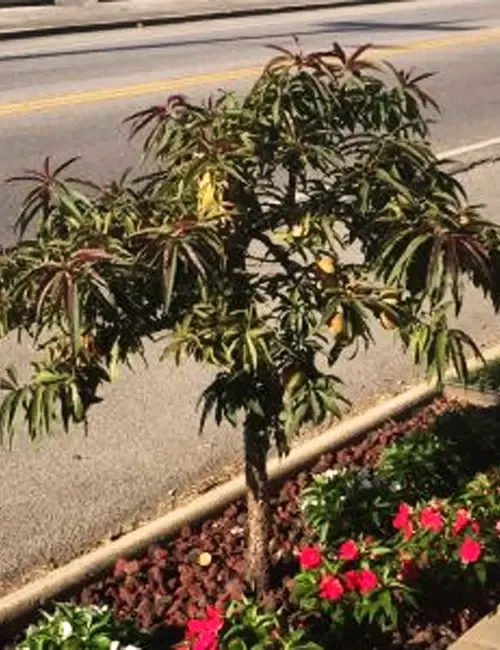
Common Name: Golden Jubilee Peach Tree
Botanical Name: Prunus persica ‘Golden Jubilee’
Family: Rosaceae
Plant Type: Deciduous fruit tree
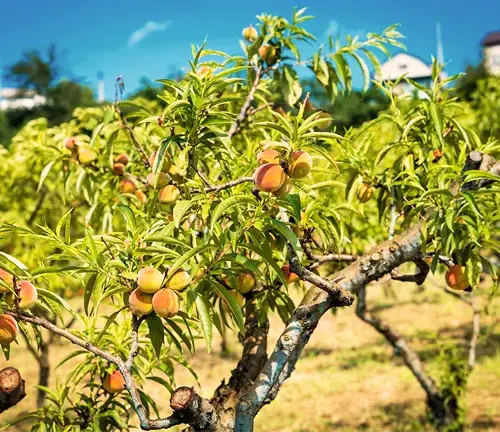
Mature Size and Growth Rate
The Golden Jubilee Peachtree is a medium-sized tree that typically reaches a height of 10 to 15 feet (3 to 4.5 meters) and spreads about 10 feet (3 meters) wide. It has a moderate growth rate, with an average increase of 1 to 2 feet (30 to 60 centimeters) per year.

Soil Type and Preference
These peach trees prefer well-drained, fertile soils. They thrive in loamy soils that retain moisture but don’t become waterlogged. A slightly acidic soil pH between 6.0 and 6.5 is ideal for optimal growth and fruit production.
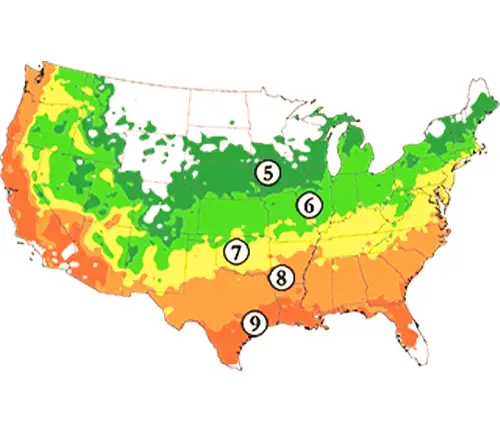
Hardiness Zones
Golden Jubilee Peach trees are hardy in USDA zones 5 to 9. They can tolerate temperatures as low as -20°F (-29°C) during winter dormancy and require a minimum chilling period of approximately 600 to 800 hours below 45°F (7°C) to produce abundant fruit.
Sun Preference
To ensure the best fruit production, Golden Jubilee Peach trees require full sun exposure. They need a minimum of six hours of direct sunlight per day.
Attributes and Characteristics
The Golden Jubilee Peachtree is renowned for its remarkable attributes and characteristics. It boasts large, golden-yellow fruit with a deliciously sweet flavor. The peaches have firm yet juicy flesh and are freestone, making them easy to separate from the pit. The skin is smooth and features a beautiful red blush that intensifies as the fruit ripens.
Wildlife Value
Golden Jubilee Peach trees attract a variety of wildlife. The fragrant blossoms entice pollinators like bees and butterflies, aiding in the tree’s reproductive process. The fruit provides nourishment for birds and small mammals, adding biodiversity to your garden or orchard.
Care
Proper care is crucial for the health and productivity of Golden Jubilee Peach trees. Here are some essential care guidelines:
- Watering: Provide regular deep watering, especially during dry spells. Aim for about 1 inch (2.5 centimeters) of water per week.
- Fertilization: Apply a balanced fruit tree fertilizer in early spring and again in late spring. Follow the manufacturer’s instructions for the appropriate amount.
- Pruning: Prune the tree during late winter or early spring to shape its structure, remove dead or diseased branches, and improve air circulation. Thinning the fruit is also necessary to promote larger, healthier peaches.
- Mulching: Apply a layer of organic mulch around the base of the tree to conserve moisture, suppress weed growth, and regulate soil temperature.
Benefits
The Golden Jubilee Peachtree offers numerous benefits for gardeners and fruit enthusiasts alike:
- Delicious Harvest: Enjoy an abundance of large, flavorful peaches with a sweet taste and juicy texture.
- Ornamental Appeal: The tree’s attractive blossoms in spring and golden fruit in summer add beauty to any landscape.
- Self-Fertile: The Golden Jubilee Peachtree is self-fertile, meaning it doesn’t require another peach tree for cross-pollination.
- Fresh and Preserved Uses: Enjoy the peaches fresh off the tree, use them in culinary creations, or preserve them as jams, jellies, or canned fruit for year-round enjoyment.
Invasive
The Golden Jubilee Peachtree is not considered invasive. However, it’s always important to monitor the growth of any plant in your garden to prevent it from spreading beyond desired boundaries.
Lifespan
Under proper care and growing conditions, Golden Jubilee Peach trees have a lifespan of approximately 15 to 20 years. However, some trees can live longer with adequate maintenance and disease prevention.
Disadvantage
One disadvantage of the Golden Jubilee Peachtree is its susceptibility to certain pests and diseases, which can affect fruit production if left unmanaged. Regular monitoring and appropriate preventive measures are necessary to mitigate potential issues.
Edible or Not
The Golden Jubilee Peach is indeed edible. Its large, golden-yellow peaches are highly sought after for their delectable taste and versatility in culinary applications.
Habitat Requirements
Golden Jubilee Peach trees thrive in regions with a temperate climate and adequate winter chilling hours. They require well-drained soil, full sun exposure, and proper air circulation to minimize the risk of disease.
Name Origin
The name “Golden Jubilee” is an homage to the tree’s exceptional fruit quality and its ability to provide abundant harvests, worthy of a jubilant celebration.
Varieties
The Golden Jubilee Peachtree is a unique cultivar within the Prunus persica species. However, there are various other peach varieties available, each with its own characteristics and flavor profiles. Some popular peach cultivars include Elberta, Redhaven, and Suncrest.
Pruning
Pruning plays a vital role in the overall health and productivity of Golden Jubilee Peach trees. Prune during late winter or early spring to remove dead or diseased wood, improve air circulation, and shape the tree’s structure. Additionally, thinning the fruit clusters helps promote larger and healthier peaches.
Propagating
Golden Jubilee Peach trees are commonly propagated through budding or grafting onto rootstocks. Budding is the preferred method, where a bud from the desired cultivar is inserted into a rootstock to establish a new tree.
Common Pests & Diseases
Golden Jubilee Peach trees are susceptible to various pests and diseases, including:
- Insects: Aphids, peach tree borers, scales, and Japanese beetles can infest the tree. Regular monitoring and appropriate insect control measures are essential.
- Diseases: Peach leaf curl, brown rot, bacterial spot, and powdery mildew are common diseases that can affect the tree. Proper sanitation, fungicide applications, and resistant cultivars can help manage these diseases effectively.
Fun Facts:
- The peach tree is native to China and has been cultivated for thousands of years.
- Peaches are a symbol of longevity and immortality in Chinese culture.
- The Golden Jubilee Peachtree is prized for its exceptional fruit quality and ornamental value, making it a popular choice among gardeners and orchard enthusiasts.
Frequently Asked Questions:
- When is the best time to harvest Golden Jubilee peaches?
Golden Jubilee peaches are typically harvested in late summer, around August to early September, depending on the specific region and climate. - Can Golden Jubilee Peach trees be grown in containers?
Yes, Golden Jubilee Peach trees can be grown in containers, provided they have sufficient space for root growth and receive adequate sunlight, water, and nutrients. - How long does it take for a Golden Jubilee Peach tree to bear fruit?
Golden Jubilee Peach trees usually begin bearing fruit within 2 to 4 years after planting, depending on growing conditions and care. - Are Golden Jubilee peaches suitable for canning or preserving?
Yes, Golden Jubilee peaches are excellent for canning, preserving, and making jams or jellies due to their large size, sweet flavor, and firm flesh. - Can I grow a Golden Jubilee Peach tree from a seed?
While it is possible to grow a peach tree from a seed, keep in mind that the resulting tree may not exhibit the same characteristics as the parent tree. It’s more reliable to propagate Golden Jubilee Peach trees through budding or grafting for consistent quality and traits.
In conclusion, the Golden Jubilee Peach tree is a delightful addition to any garden or orchard. With its luscious golden peaches, ornamental beauty, and exceptional flavor, it offers a fruitful celebration of nature’s bountiful gifts. With proper care and attention, this tree can provide years of enjoyment and mouthwatering harvests for all peach enthusiasts.

John Carlos
Forestry AuthorThe beauty of logging isn't just about felling trees. It's about understanding nature, mastering the art of chainsaws, and respecting the environment. I believe in sharing my experiences and knowledge, ensuring that we move towards a sustainable future together.


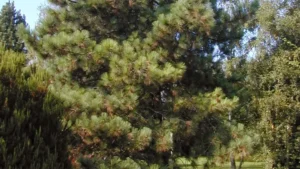
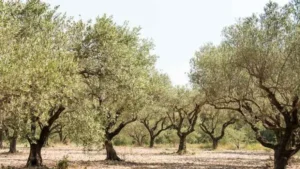



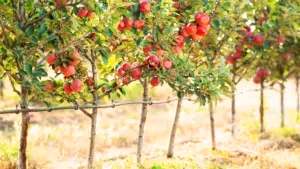
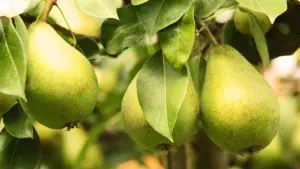




Leave your comment